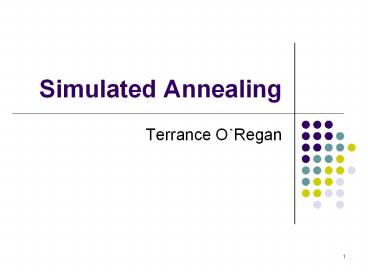Simulated%20Annealing - PowerPoint PPT Presentation
Title:
Simulated%20Annealing
Description:
Simulated Annealing algorithms are usually better than greedy algorithms, when ... Simulated Annealing is not the best solution to circuit partitioning or placement. ... – PowerPoint PPT presentation
Number of Views:1990
Avg rating:3.0/5.0
Title: Simulated%20Annealing
1
Simulated Annealing
- Terrance ORegan
2
Outline
- Motivation
- The algorithm
- Its applications
- Examples
- Conclusion
3
Introduction
- Various algorithms proposed for placement in
circuits. - Constructive placement vs Iterative improvement.
- Simulated Annealing an iterative improvement
algorithm.
4
Motivation
- Annealing in metals
- Heat the solid state metal to a high temperature
- Cool it down very slowly according to a specific
schedule. - If the heating temperature is sufficiently high
to ensure random state and the cooling process is
slow enough to ensure thermal equilibrium
(adiabatic cooling), then the atoms will place
themselves in a pattern that corresponds to the
global energy minimum of a perfect crystal.
5
Simulated Annealing
- Step 1 Initialize Start with a random initial
placement. Initialize a very high temperature. - Step 2 Move Perturb the placement through a
defined move. - Step 3 Calculate score calculate the change in
the score due to the move made. - Step 4 Choose Depending on the change in
score, accept or reject the move. The probability
of acceptance depending on the current
temperature. - Step 5 Update and repeat Update the temperature
value by lowering the temperature. Go back to
Step 2. - The process is done until Freezing Point is
reached.
6
Algorithm for placement
- Algorithm SIMULATED-ANNEALING
- Begin
- temp INIT-TEMP
- place INIT-PLACEMENT
- while (temp gt FINAL-TEMP) do
- while (inner_loop_criterion FALSE) do
- new_place PERTURB(place)
- ?C COST(new_place) - COST(place)
- if (?C lt 0) then
- place new_place
- else if (RANDOM(0,1) gt e-(?C/temp)) then
- place new_place
- temp SCHEDULE(temp)
- End.
7
Parameters
- INIT-TEMP 4000000
- INIT-PLACEMENT Random
- PERTURB(place)
- 1. Displacement of a block to a new position.
- 2. Interchange blocks.
- 3. Orientation change for a block.
- COOLING SCHEDULE.
8
Cooling Schedule
- The algorithm employs a random search which not
only accepts changes that decrease the objective
function (cost function), but also some changes
that increase it. The latter are accepted with a
probability - Thus, temperature is a control parameter and must
be chosen carefully.
Probability exp-(?C/T)
9
Cooling schedule (continued)
- The chance of getting a good solution can be
traded off with computation time by slowing
down the cooling schedule. - The slower the cooling, the higher the chance of
finding the optimum solution, but the longer the
run time. - Thus effective use of this technique depends on
finding a cooling schedule that gets good enough
solutions without taking too much time.
10
Convergence of simulated annealing
11
Ball on terrain example Simulated Annealing
Vs. Greedy Algorithms
The ball is initially placed at a random
position on the terrain. From the current
position, the ball should be fired such that it
can only move one step left or right.What
algorithm should we follow for the ball to
finally settle at the lowest point on the terrain?
12
Ball on terrain example SA vs Greedy Algorithms
13
Algorithm for partitioning
- Algorithm SA
- Begin
- t t0
- cur_part ini_part
- cur_score SCORE(cur_part)
- repeat
- repeat
- comp1 SELECT(part1)
- comp2 SELECT(part2)
- trial_part EXCHANGE(comp1, comp2, cur_part)
- trial_score SCORE(trial_part)
- ds trial_score cur_score
- if (ds lt 0) then
- cur_score trial_score
- cur_part MOVE(comp1, comp2)
- else
- r RANDOM(0,1)
- if (r lt e-(ds/t)) then
- cur_score trial_score
14
Qualitative Analysis
- Randomized local search.
- Is simulated annealing greedy?
- Controlled greed.
- Once-a-while exploration.
- Is a greedy algorithm better? Where is the
difference? - The ball-on-terrain example.
15
Applications
- Circuit partitioning and placement.
- Strategy scheduling for capital products with
complex product structure. - Event-based learning situations.
- Almost any optimization problem (if you cant
find a better method)
16
Traveling Salesman Problem
- A salesman spends his time visiting n cities (or
nodes) cyclically. In one tour he visits each
city just once, and finishes up where he started.
In what order should he visit them to minimize
the distance traveled? - A simple Java Applet is found here
- http//www.math.uu.nl/people/beukers/anneal/anneal
.html
17
Conclusions
- Simulated Annealing algorithms are usually better
than greedy algorithms, when it comes to problems
that have numerous locally optimum solutions. - Simulated Annealing is not the best solution to
circuit partitioning or placement. Network flow
approach to solving these problems functions much
faster. - Simulated Annealing guarantees a convergence upon
running sufficiently large number of iterations.
18
Thank You!































